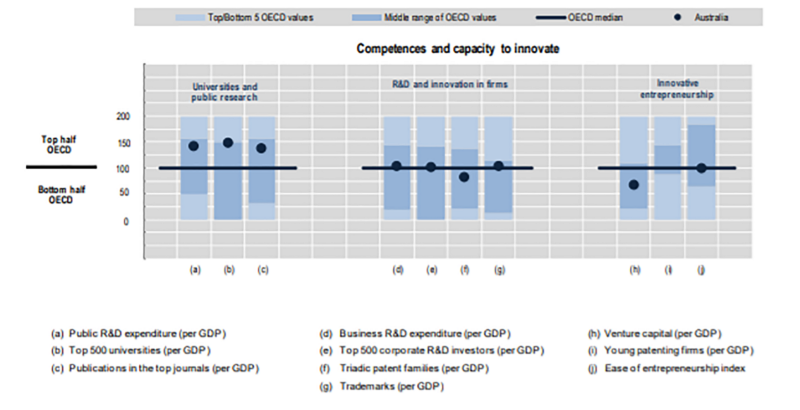
The Turnbull Government has placed itself in the middle of an ‘ideas boom’ making innovation a core aim for its term in office. Innovation in this context is focused both on developing new ideas and translating them into commercial products that can drive the Australian economy. With a rising aging community, a key question that needs to be answered is how readily does government spending translate into a commercially viable health innovation ecosystem?
Analysis of Australian government spending and outcomes leads to mixed results when considering whether both aspects of innovation are being achieved. Over the eight years from 2008–2016, Australia’s research and development expenditure increased 9% in real terms compared to decreased funding in France, the United Kingdom, and the United States. This increase means that Australia ranks 10th in the OECD in terms of total government expenditure into research and development as a percentage of GDP. While this supports the idea that Australia is well-positioned to focus on promoting the development of new ideas, funding peaked in 2009–10. Additionally, the primary source of funding occurs through tax incentives, with 85% of the Federal Government’s research and development expenditure taking this form. Tax incentives are common in the OECD and studies conducted on similar UK incentives have shown that they do increase research output, however, these schemes have the potential to be exploited by businesses lodging fraudulent tax assessments which have been slowing down the refund process. Despite the questionable means of funding distribution, 18.5% of Australia’s research and development funding is funneled into health innovation, the third-highest percentage in the OECD.
Despite a declared government focus on innovation, there are questions surrounding the commercial outcomes of our research spending. OECD statistics reveal that although Australia is well above the OECD median in public research funding and top journal publications Australia is falling behind the OECD median in the creation of international patents and in raising venture capital. These findings suggest that although Australia is achieving impressive research outcomes it is failing to commercialize this research. This is concerning as it is this final step of commercializing products that the Turnbull government is seeking to achieve in its ‘ideas boom’.

Recent government grant schemes aimed directly at driving innovation in the medical technology space could help to halt this decline. Programs such as MTPConnect and the Biomedical Translation Fund allow Australian innovators to access grants to convert research ideas into viable commercial products. This new focus on innovation should assist researchers through the translational and implementation stages of their proposed products and help Australia improve our innovation. MTPConnect focuses on trying to convert Australia’s large research output into viable commercial products to help drive Australia’s economy. This focus will directly target the shortfalls identified in the OECD report.
Though a step in the right direction further research should be conducted on how best to support and measure innovation in Australia. Patents and VC investment are only one measure of successful commercialization. More data is required across the lifetime of innovations to ensure that future increases in expenditure or regulatory changes are focused on practical measures that will have direct impacts on assisting Australian innovators.
We think we need additional tools to better track innovation, and that there is enough information on the internet to do this. Health Horizon is a platform designed to track and monitor health innovations. Through Australia’s Health Innovation Showcase which launched on the 26th of February researchers, entrepreneurs and the public are able to view, monitor, or submit Australian health innovations. This platform will provide both government and industry groups with a practical assessment both of how and where health innovations are taking place, but also data on where these innovations struggle. This will help to guide future government action by allowing better targeting of policies and grant schemes to assist Australian researchers.
If you visit the Australian Showcase you can see how we are tracking innovation, and if you have any additional metrics you think we should be tracking comment on this article.
